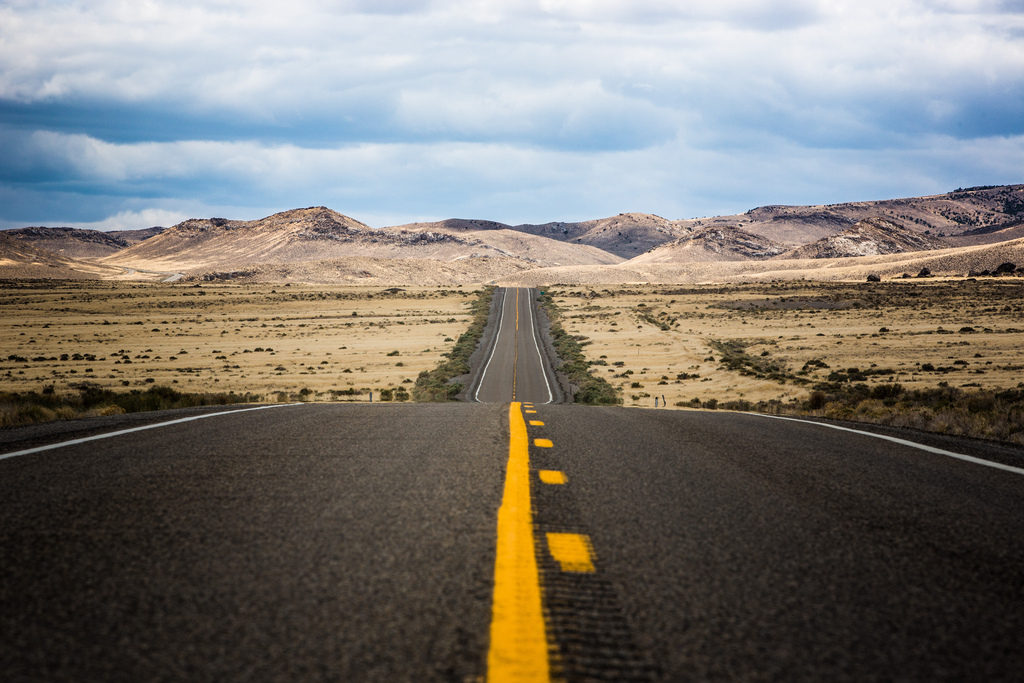The Daily Escape:

Lincoln Highway – photo by Andrew Smith. The Lincoln Highway was the first highway to connect the east and west coasts of the USA in 1916. It was a combination of newer and older roads of varying quality.
Eisenhower’s National Highway System had its origin in a road trip that he took across the country in 1919, 33 years before he was elected president. From Atlas Obscura:
Lt. Colonel Dwight D. Eisenhower traveled with the military in a motor convoy across the country, from DC to San Francisco… This was one of the first major cross-country road trips, and it planted the idea in Eisenhower’s mind that the federal government could and should make improving US highways a priority…
In 1919, America’s network of roads that Eisenhower traveled on was, for the most part, still rudimentary.
In 1916, the Lincoln Highway had been designated, but it wasn’t a proper highway. The Eisenhower convoy mostly traveled the Lincoln Highway, with some detours. The motorcade included more than 80 vehicles. It left Washington DC on July 7, 1919, and took seven and a half hours to reach its first stop at Frederick, Maryland, a distance of 46 miles. That’s where Eisenhower joined the group.
That 6 miles an hour pace is what the convoy would average in its drive across the country. It took them 62 days to make it to San Francisco.
In 1919, usable roads hardly existed west of Indiana. When it rained, vehicles got stuck in soft spots on the roads, up to their hubs, and had to be pushed out. In Nebraska, they found sand to be the enemy. One day, it took seven hours to pull all the trucks through 200 yards of quicksand.
Elected in 1952, Eisenhower hoped to build the highways that he had talked about for years. The Federal-Aid Highway Act of 1944 had authorized the construction of a 40,000-mile “National System of Interstate Highways”, but hadn’t provided funding to pay for the construction.
Eisenhower’s new Federal-Aid Highway Act passed in June 1956. It authorized the construction of a 41,000-mile network of interstate highways spanning the nation. It also allocated $26 billion to pay for them. The federal government would pay 90% of the costs of construction, using a national fuel tax.
Thereafter, that great American institution, the road trip, could begin. Today, the Interstate Highway System is more than 46,000 miles long.
Flash forward to 2018. We know public spending peaked at 2.2% of inflation-adjusted GDP in 2009 and has fallen ever since. By late last year, it was down to about 1.6%.
President Trump said while introducing his new infrastructure plan:
It is time to give Americans the working, modern infrastructure they deserve.
Reading Trump’s plan, it is clear he thinks we deserve nothing. Disagree? Start by looking at Trump’s budget proposal. Jared Bernstein says:
The budget proposes $200 billion over 10 years, but as budget analyst Bobby Kogan tweeted: “The budget cuts $178 billion in…transportation [not including cuts to] water, broadband…and energy. This means [Trump is] giving $200 billion with his left hand but taking away that much with his right.”
$20 billion a year doesn’t go very far. The plan shifts at least 80% of the investment in infrastructure to private investors, states, and cities. This is problematic, because Trump’s tax plan significantly lowers the amount of federal taxes that state and local taxpayers can deduct from their tax bill. This will make it much harder for states and cities to raise the revenue to support infrastructure spending, or any other public needs.
The LA Time’s Michael Hiltzik says it best: (brackets and emphasis by Wrongo)
The whole package should mostly be seen as [typical of] the Trump administration’s approach to governing: programs with virtually no rationale and without adequate financing, along with a commitment to getting government off the backs of the people so Big Business can saddle up.
This is Right Wing ideology at work. They passed a huge tax cut in order to “starve the beast” that is the US government, while at the same time, they will “feed the beast” via $trillions of deficit financing. Cities and states are not flush with cash for new infrastructure projects, and the private sector won’t do anything that reduces shareholder return, so Trump’s plan is dead on arrival.
As for financing America’s roads, increase fuel taxes. Let drivers amortize the building costs, a system Eisenhower used. Add tolls where we must. Make the traffic move faster and safer.
Trump should be like Ike: Pay for our infrastructure!
Claw back some tax cuts. Cut defense spending. Pay for purer water for our towns and cities. Pay for better schools, a smart electric grid, and better ports and airports.
Pay for them all with federal dollars.
(Wrongo is indebted to the tywkiwdbi blog for covering the Eisenhower road trip on Lincoln’s birthday)

“Economist” Laffer continues to prattle on, secure that he can find a paying audience anywhere that greedy people congregate and wish to be reassured that they made their own success. And the governor who stripped Kansas of its prosperity will also find a safe place, sucking up to the same rich folks.
Prosperity can only exist when shared. If not shared, the nation is not prosperous at all.